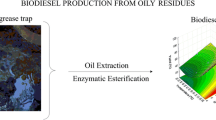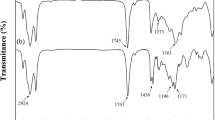Abstract
Oil obtained from the seeds of Manilkara zapota (L.) was transesterified with methanol using lipases as biocatalysts. Four commercially available lipases, such as, porcine pancreas, Candida rugosa, Pseudomonas cepacia and Candida antarctica-B were used for biodiesel preparation. Novozyme-435 (C. antarctica lipase-B immobilized on acrylic resin) and CLEA (cross-linked enzyme aggregate) of C. antarctica lipase-B were compared for their biodiesel production potential. Under optimized reaction conditions, Novozyme-435 gave 96% biodiesel yield in 12 h; whereas, CLEA of C. antarctica-B gave 84% yield of biodiesel. Novozyme-435 was reused for six cycles and 72% biodiesel was formed at the end of 6th cycle. The deactivated Novozyme-435 was regenerated by incubating it in soybean oil, 2-butanol and tert-butanol.
Similar content being viewed by others
Explore related subjects
Discover the latest articles, news and stories from top researchers in related subjects.Avoid common mistakes on your manuscript.
Introduction
The world at large relies upon petroleum based fuels for daily energy needs. Most countries are dependent on handful of nations for the supply of fossil fuel—a finite resource. Such over dependency on fossil fuels is risky, since continuous fuel supply is dependent on international relations between countries. Therefore, all-time supply of fossil fuels from this region cannot be guaranteed. In addition, consumption of fossil fuel also causes increase in air pollution. Hence, developing and developed countries are investing heavily on the development of various alternative fuels. Along this line, biodiesel (fatty acid methyl esters) is a potential liquid fuel that is synthesized from a variety of oils, fats, and greases [1]. Biodiesel is commercially available in many countries. In general, biodiesel is considered beneficial for farmers because it has created a defined market for oils, fats and oil rich feedstocks; farmers have the opportunity to grow biofuel plants and in turn the generated biofuels can then be used in agriculture-related processing industries and sufficient biodiesel production will decrease dependency on Gulf countries. Biodiesel is mainly produced from edible oils (feedstocks) such as soybean, canola, and corn oil [2]. Typically, feedstock accounts for 70–80% of the total biofuel cost [3]. To make biodiesel cost effective, new oil-rich low-cost feedstocks viz. non-edible oils, discarded fats, food waste, sludge, and waste cooking oils are being investigated [4–10].
There is an ongoing necessity to identify oil rich plant species that are growing well on marginal lands. In the above context, oil rich seeds obtained from native marginalised plants and agricultural sources can be used as potential sources for biodiesel preparation. In this regard, M. Zapota L., a small tree native to Mexico and tropical America is now spread throughout regions with tropical climate [11, 12]. In India, it is called “Chiku or Sapota” by local people. Fruits of M. Zapota L. plant are sold widely in India. The fruits are sweet with high quantities of energy, vitamins, and antioxidants [13–17]. After eating the fruits, the resulting seeds are generally discarded due to lack of awareness and collection facilities. The seeds of M. Zapota L. are highly underutilized. Such underutilized seeds are potential candidates for biodiesel production. Local people in the rural areas collect the seeds and prepare oil from it. In some parts of India, this oil is used for lamp lighting. Manilkara Zapota L. plant oil was investigated for biodiesel production using chemical catalysts. Kumar et al. obtained 94.83% of biodiesel via KOH catalysed transesterification [18, 19]. Chemo-catalysts, in particular, KOH and NaOH are highly moisture sensitive. Presence of moisture can lead to saponification; which is known to affect the yield of biodiesel adversely.
Lipases are enzymes that hydrolyse triglycerides as natural substrates. In both conventional and non-conventional media, lipases are known to catalyse esterification, transesterification and inter-esterification reactions [20–25]. As an alternative to the chemical catalysts, lipases can be used for biodiesel production; since, they are moisture tolerant [7, 26]. Lipase catalysed biodiesel production is carried out under mild reaction conditions. Furthermore, they can be used for many reaction cycles. Therefore, lipases are extensively investigated for biodiesel production using different feedstocks. In this work, lipases are used for the preparation of biodiesel from M. Zapota L. seed oil (Fig. 1).
Materials and Methods
Candida antarctica lipase-B (Novozym 435, immobilized on polyacrylic resin), C. antarctica lipase-B CLEA (cross-linked enzyme aggregate), Candida rugosa (Type VII), porcine pancreas (Type II) and P. cepacia were obtained from Sigma–Aldrich. All other chemicals such as methanol, n-heptane, ethyl acetate, soybean oil, tert-butanol, 2-butanol and sodium sulphate were reagent grade. Crude M. Zapota (L.) oil was purchased from oil mills of Koraput, Odisha, India. Incubator (Orbitrek, India) was used for all experimental purposes. The methanol was distilled by simple laboratory distillation procedure using round bottom flask, condenser, cooling water, receiving flask and stirrer cum heat plate. The obtained methanol was stored in molecular sieves before its use in transesterification. 1HNMR spectra were recorded using a Bruker (400 MHz) spectrometer (Bruker, Massachusetts, USA). Tetramethylsilane (TMS) was used as an internal standard and CDCl3 was used as a solvent. Molecular weight of M. zapota oil 873.95 g/mol was used for all calculation purposes [18, 19].
Screening of Lipases
Generally, transesterification reactions were carried out in 50 mL screw capped conical flasks containing M. Zapota (L.) oil (1.31 g, 1.5 mmol), methanol (0.351 mL, 4.5 mmol) and different types of lipases (10 wt% with respect to oil). All reactions were performed at 40 °C and 200 rpm for 4 h. Enzymes were filtered off after the reaction and the resulting samples were analysed by 1H NMR spectrometry.
Transesterification of M. Zapota (L.) Oil at Different Lipase Loadings
Transesterification reactions were carried out exactly as described in the “screening of lipases” protocol using various amounts of C. antarctica lipase-B (5, 10, 15, 20 and 25 wt%). All the reactions were performed at 40 °C and 200 rpm for 4 h. After completion of the reactions, the lipase was carefully filtered using whatman qualitative filter paper and conical flask. The obtained samples were analysed by 1H NMR.
Transesterification of M. Zapota (L.) Oil via “Sequential Addition of Methanol”
Transesterification reaction was initiated by addition of methanol (0.351 mL, 4.5 mmol) to a mixture of M. Zapota (L.) oil (1.31 g, 1.5 mmol) and Novozyme-435 (10 wt%). The reaction was carried out in a shaker (200 rpm) at 40 °C. Additional methanol (0.351 mL, 4.5 mmol × 2) was added in a stepwise manner to the reaction after 4 and 8 h. Then, the reaction was let to proceed until 24 h. In total, 13.5 mmol of methanol was reacted with 1.5 mmol of oil. Analysis and workup of the reaction were done as described in the “screening of lipases” method.
Reusability of Candida antarctica Lipase-B (Novozym-435)
The reaction was performed as stated for the “sequential addition of methanol” protocol. After each reaction, the enzyme was filtered off, washed using heptane (1 mL × 3) and then reused for the next cycle. Analysis and workup of all the reactions were carried out as described before. The lipase was reused for six consecutive cycles.
Regeneration of Novozym-435
Oil Washing
The lipase was washed using soybean oil (5 mL) three times and stored in soybean oil (5 mL) overnight in an incubator at 30 °C.
2-Butanol Washing
The enzyme was washed using 2-butanol (10 mL) three times and then it was washed using soybean oil. The lipase was separated by filtration and stored in an incubator overnight at 30 °C in a glass vial.
Tert-butanol Washing
The enzyme was washed using tert-butanol (10 mL) for three times. Later, it was washed using soybean oil (5 mL). The obtained lipase was stored in an incubator overnight at 30 °C in a glass vial.
Results and Discussion
Search for new feedstocks such as plant oils, food waste, sewage sludge, municipal organic waste for biofuel production is a part of ongoing research on renewable energy [27–30]. In this context, preparation of biodiesel from marginalized plant seed oil is of significant importance. Four commercially available lipases viz. C. antarctica lipase-B (Novozym 435, immobilized on polyacrylic resin), Candida rugose (Type VII), porcine pancreas (Type II) and P. cepacia were used for biodiesel production from crude M. Zapota oil. Conversion of oil to biodiesel was determined by 1H NMR (Fig. 2). Among the lipases screened, C. antarctica lipase-B gave highest conversion (28%) at 1:3 molar ratio of oil to methanol and at 40 °C (Fig. 3). Therefore, C. antarctica lipase-B was chosen for the optimization of reaction parameters.
Effect of the lipase amount (C. antarctica lipase-B) on the yield of fatty acid methyl esters was studied. It was found that 10 wt% of lipase with respect to weight of oil gave highest biodiesel yield (29%) after 4 h of reaction (Fig. 4).
Addition of high quantities of methanol to oil causes deactivation of lipases during biodiesel preparation. Water-miscible polar organic solvents are known to deactivate lipases more than water-immiscible solvents [31]. Thus, to avoid deactivation of lipases, methanol was added in a step-wise manner to oil. Initially, methanol (4.5 mmol) was added to a mixture of M. Zapota (L.) oil (1.5 mmol) and Novozyme-435 (10 wt%). The reaction was performed at 40 °C and 200 rpm. Afterwards, additional methanol (4.5 mmol × 2) was added in a step-wise approach to the reaction mixture at 4 and 8 h (Fig. 5). Then the reaction was left to run for 24 h. Using Candida antartica lipase-B (Novozyme-435) 93% biodiesel was obtained after 12 h of reaction (Fig. 5). Under similar reaction conditions CLEA of Candida antartica lipase-B gave 84% of biodiesel (Fig. 5). Earlier report show that Novozyme-435 was efficiently used for biodiesel production from food waste lipid and 90% of FAME yield was achieved after 24 h of reaction [26]. Han and Kim reported the application of CLEA of Photobacterium lipolyticum lipase M37 for biodiesel preparation from olive oil in 64% yield [32]. Along this line, CLEAs of C. antarctica lipase B which are covalently bound to magnetic nanoparticles was employed for conversion of non-edible vegetable and waste frying oils to biodiesel [33].
Furthermore, reusability test of Novozyme-435 was conducted. After 6th cycle, 72% of biodiesel was obtained (Fig. 6). The deactivated lipase was regenerated by different washing methods [34]. For instance, t-butanol washing gave 91% of biodiesel; whereas, 2-butanol and oil washing gave 84 and 77% of biodiesel respectively (Fig. 7).
Conclusions
Oil from marginalized seed of M. Zapota (L.) was used as a feedstock for biodiesel production. Two immobilized forms of Candida antartica lipase-B, namely, Novozyme-435 and CLEA were found to be potential biocatalysts for the transesterification of M. Zapota (L.) seed oil. Novozyme-435 was reused up to 6th cycle with 21% loss of activity. The deactivated lipase was regenerated after tert-butanol washing. The protocol presented here, offers a facile, low-cost and sustainable approach for synthesis of biodiesel from M. Zapota (L.) seed oil. This method can be extended to conversion of oils from other marginalized plant seeds and waste oils to biodiesel. Additionally, immobilized lipases can be exploited for utilization of low-cost biomass into liquid fuel and other value added products.
References
Baskar, G., Aiswarya, R.: Trends in catalytic production of biodiesel from various feedstocks. Renew. Sust. Energy. Rev. 57, 496–504 (2016)
Patil, P. D., Deng, S.: Optimization of biodiesel production from edible and non-edible vegetable oils. Fuel. 88(7), 1302–1306 (2009)
IEA (International Energy Agency) Biofuels for transport: an international perspective. 2004. http://citeseerx.ist.psu.edu/viewdoc/download?doi=10.1.1.125.7017&rep=rep1&type=pdf. Accessed 06 June 2016.
Karmee, S. K., Chandna, D., Ravi, R., Chadha, A.: Kinetics of base catalysed transesterification of triglycerides from Pongamia oil. J. Am. Oil Chem. Soc. 83, 873–877 (2006)
Karmee, S. K., Chadha, A.: Preparation of biodiesel from crude oil of Pongamia pinnata. Bioresour. Technol. 96, 1425–1429 (2005)
Karmee, S. K., Mahesh, P., Ravi, R., Chadha, A.: Kinetics of transesterification of monoglycerides from Pongamia oil. J. Am. Oil Chem. Soc. 81, 425–430 (2004)
Karmee, S. K.: Lipase catalyzed synthesis of fatty acid methyl esters from crude Pongamia oil. Energy Source Part A. 37, 536–542 (2015)
Karmee, S. K., Patria, R. D., Lin, C. S. K.: Techno-economic evaluation of biodiesel production from waste cooking oil—a case study of Hong Kong. Int. J. Mol. Sci. 16(3), 4362–4371 (2015). doi:10.3390/ijms16034362
Karmee, S. K., Lin, C. S. K.: Valorisation of food waste for biofuel production: current trends and technological challenges. Sustain. Chem. Process. 2, 22 (2014). doi:10.1186/s40508-014-0022-1
Karmee, S. K., Lin, C. S. K.: Lipids from food waste as feedstock for biodiesel production: Case Hong Kong. Lipid Technol. 26 (9), 206–209 (2014)
van Royen, Orwa, C., Mutua, A., Kindt, R., Jamnadass, R., Simons, A.: Agroforestree database: a tree reference and selection guide version 4.0 (http://www.worldagroforestry.org/af/treedb/) (2009)
Flora of North America. http://www.efloras.org/florataxon.aspx?flora_id=1&taxon_id=200017540
Kaneria, M., Chanda, S.: Evaluation of antioxidant and antimicrobial properties of Manilkara zapota L. (chiku) leaves by sequential soxhlet extraction method. Asian Pac. J. Trop. Biomed. 2(3), S1526–S1533 (2012)
Ma, J., Luo, X.-D., Protiva, P., Yang, H., Ma, C., Basile, M. J., Weinstein, I. B., Kennelly, E. J.: Bioactive novel polyphenols from the Fruit of Manilkara zapota (Sapodilla). J. Nat. Prod. 66, 983–986 (2003)
Shui, G., Wong, S. P., Leong, L. P.: Characterization of antioxidants and change of antioxidant levels during storage of Manilkara zapota L. J. Agric. Food Chem. 52, 7834–7841 (2004)
Wang, H., Liu, T., Song, L., Huang, D.: Profiles and α-amylase inhibition activity of proanthocyanidins in unripe Manilkara zapota (Chiku). J. Agric. Food Chem. 60, 3098–3104 (2012)
Isabelle, M., Lee, B. L., Lim, M. T., Koh, W.-P., Huang, D., Ong, C. N.: Antioxidant activity and profiles of common fruits in Singapore. Food Chem. 123, 77–84 (2010)
Kumar, R. S., Sureshkumar, K.: Manilkara zapota (L.) seed oil: a new third generation biodiesel resource. Waste Biomass. Valoriz. doi: 10.1007/s12649-016-9491-7
Kumar, R. S., Sureshkumar, K., Velraj, R.: Optimization of biodiesel production from Manilkara zapota (L.) seed oil using Taguchi method. Fuel. 140, 90–96 (2015)
Karmee, S. K., Casiraghi, L. ,Greiner, L.: Technical aspects of biocatalysis in non-CO2 based supercritical fluids. Biotechnol. J. 3, 104–111 (2008)
Karmee, S. K., Niemeijer, B., Casiraghi, L., Mlambo, B., Lapkin, A., Greiner, L.: Facile bio-catalytic synthesis of a macrocyclic lactone in sub- and supercritical solvents. Biocatal. Biotransformation 32(2), 125–131 (2014)
Karmee, S. K.: A chemo-enzymatic reaction sequence for the synthesis of dihydroxyacetone phosphate stock material. Synth. Commun. 43, 450–455 (2013)
Karmee, S. K., van Oosten, R., Hanefeld, U.: Kinetic resolution of 3-hydroxycyclohexanone using different lipases. Tetrahedron: Asymmetry. 22, 1736–1739 (2011)
Karmee, S. K.: Biocatalytic synthesis of ascorbyl esters and their biotechnological applications. Appl. Microbiol. Biotechnol. 81(6), 1013–1022(2009)
Karmee, S. K.: Lipase catalyzed synthesis of surfactants from biomass derivatives. Biofuels Bioprod. Biorefining 2(2), 144–154 (2008)
Karmee, S. K., Linardi, D., Lee, J., Lin, C. S. K.: Conversion of lipid from food waste to biodiesel. Waste Manag. 41, 169–173 (2015)
Karmee, S. K.: Liquid biofuels from food waste: current trends, prospect and limitation. Renew. Sustain. Energy Rev. 53, 945–953 (2016)
Kwon, E. E., Kim, S., Jeon, Y. J., Yi, H.: Biodiesel production from sewage sludge: new paradigm for mining energy from municipal hazardous material. Environ. Sci. Technol. 46(18), 10222–10228 (2012)
Mondala, A., Liang, K., Toghiani, H., Hernandez, R., French, T.: Biodiesel production by in situ transesterification of municipal primary and secondary sludges. Bioresour. Technol. 100(3), 1203–1210 (2009)
MSW as a feedstock for biofuels production. http://biofuelstp.eu/msw.html
Zaks, A., Klibanov, A. M.: Enzyme-catalyzed processes in organic solvents. Proc. Natl Acad. Sci. U.S.A. 82(10), 3192–3196 (1985)
Han, J. Y., Kim, H. K.: Transesterification using the cross-linked enzyme aggregate of Photobacterium lipolyticum lipase M37. J. Microbiol. Biotechnol. 21(11), 1159–1165 (2011)
Cruz-Izquierdo, A., Pico, E. A., Lopez, C., Serra, J. L., Llama, M. J.: Magnetic cross-linked enzyme aggregates (mCLEAs) of Candida antarctica lipase: an efficient and stable biocatalyst for biodiesel synthesis. PLOS ONE 1–22 (2014) DOI:10.1371/journal.pone.0115202.
Chen, J.-W., Wu, W.-T.: Regeneration of immobilized Candida antarctica lipase for transesterification. J. Biosci. Bioeng. 95(5), 466–469 (2003)
Author information
Authors and Affiliations
Corresponding author
Rights and permissions
About this article
Cite this article
Karmee, S.K. Enzymatic Biodiesel Production from Manilkara Zapota (L.) Seed Oil. Waste Biomass Valor 9, 725–730 (2018). https://doi.org/10.1007/s12649-017-9854-8
Received:
Accepted:
Published:
Issue Date:
DOI: https://doi.org/10.1007/s12649-017-9854-8











